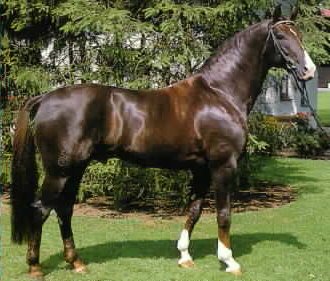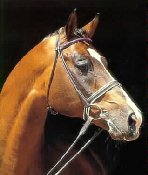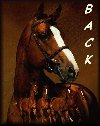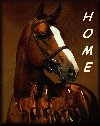Oldenburg

The Oldenburg, the heaviest of the German warmbloods, was established in the 1600s, largely through the efforts of Count Anton Gunther von Oldenburg. He used target="_blank"the halfbred stallion, Kranich, and a base of Friesians.
To this Friesian base were added Spanish Horses, Barbs, Neapolitans and English halfbreds, and during the ninteenth century the breeders introduced Thoroughbreds, Cleveland Bays, Hanoverians, and French Norman strains. The resultant horse was 17hh and heavily built. Despite its size and build, it was noted for its early maturity. With the decliine in demand for heavy coach horses, the breed developed as a general-purpose farm horse. When demand changed again, after 1945, more Thoroughbred and Norman blood was introduced to make the Oldenburg closer to a riding type. Today it is an all-purpose riding horse, still big and powerful and retaining some of the harness horses' knee action, but much freer than its ancestors.

The head can be described as plain but honest. The profile is straight but a tendency toward a Roman nose is common. There is occasionally some thickness of the jowl. The expression is essentially kind and genuine and the eye has a hint of boldness. The neck is long and very strong but still reflects the coaching background. To carry such a big frame, the limbs are strong and short with large, well-developed joints, short cannons and a bone measurement below the knee that is upward of 9". The placement and length of the humerus in respect of the scapula accounts for the fairly high knee action. When stallions are tested before licensing, particular attention is paid to the hooves. In such a big animal, they must be well open at the heels, large enough in proportion to the horse and of sound quality. Of all the warmblood riding horses, the Oldenburg is the most powerfully built. The chest is exceptionally deep, which contributes to the action. The shoulder does not reflect that of the Thoroughbred in length and shape and, combined with the width of the chest, in not conducive to speed. However, the paces are rhythmical and even elastic, with the horse moving very correctly. The quarters and the hindlimbs are very strong. Although the Oldenburg is not built for speed, it is known as a powerful jumper, as well as being a good performer in dressage competitions. The tail is set and carried noticeably high in the strong quarters. Colors in the breed are mostly brown, black and bay. Chestnuts and grays are usually unseen. The height of the Oldenburg is upward of 16.2-17.2hh.
Reference: The Ultimate Horse Book; Elwyn Hartley Edwards; 1991
Oldenburg Links
Island Farm
Oldenburg Registry



Background photo of Alpenstern courtesy of Island Farm


Home / Equine History / Caring for your Horse /
Equine Massage / General Information /
Horses and Water / Rescue/Abuse Issues / Breed Descriptions /
Breed Temperament / Styles of Riding / Health and Development /
First Aid Information /
Stable Plans / Repairs /
Accident Proof Your Barn / Trailer Shopping / Used Trailers /
Money Saving Tips /
Showing On A Budget /
Equine Link (Add Yours) / Equine Gallery / Equine Library



